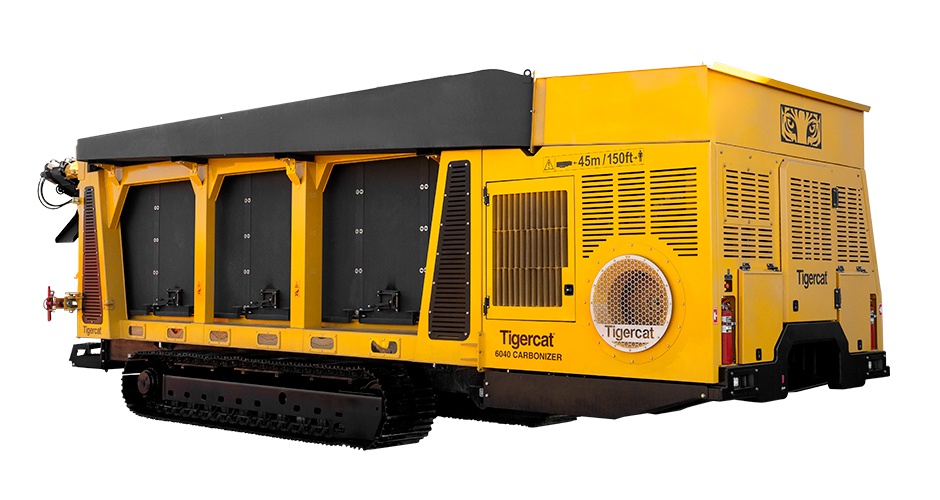New From Tigercat: 6040 Carbonizer
Tigercat Industries has announced the official release of its 6040 carbonizer—which replaces the 6050 carbonator that Tigercat marketed for a brief time after acquiring the product through the purchase of ROI in 2019. The mobile onsite wood conversion system is once again available after a comprehensive, ground-up redesign.
The 6040 is one of the most environmentally friendly wood debris reduction and conversion systems available on the market. The machine inputs woody debris and produces a high-quality organic carbon with up to 90% material reduction. It is an ideal solution for converting unwanted logging and agriculture residue into a useful, high grade organic carbon that can be left onsite as a soil additive or marketed for many different commercial uses. The process captures 20 to 30% of the available carbon in the feedstock and sequesters it for thousands of years, furthering the goals of greenhouse gas reduction. The innovative conversion process operates at high throughput levels and produces very low emissions because the gasses are combusted in the controlled combustion zone.
The 6040 redesign addresses performance related issues experienced in the original design and represents the knowledge of the applications that Tigercat engineers and field support personnel have gained over the past five years. The grates in the carbonizing chamber are now made up of seven different sections that can be rotated 180° to balance wear and extend life. Individual sections can be replaced as required. The undercarriage, auger trough, and conveyor system are all bolt-on sections to the main carbonizing chamber frame. Everything can be separated for service and replacement if required. The modular bolt-on design also allows for differing expansion rates of these major components.
The replaceable thermal-ceramic panel seal plate design has been improved, reducing panel wear. The composition of the panels has been altered to decrease back-face temperature while storing and utilizing more of the heat energy produced during the carbonizing process. This provides a more stable and sustained temperature within the carbonizing chamber. The result is increased efficiency, higher infeed rates, reduced emissions, and a greater yield of higher quality organic carbon.
The auger trough is designed for minimal air leakage, assisting with under-air efficiency, further defining the secondary combustion zone, while reducing hotspots that could form from an inefficient base pressure or vacuum. Unlike the 6050, the auger trough, where the quenching process takes place, is entirely sealed. Once the organic carbon drops through the grates, it is fully quenched by the water bath. An onboard hydraulic water supply pump and integrated automatic water level control system reduces water consumption by about 50% compared with the 6050. Automated water fill, level control, and water retention provides the operator a window of time to replenish the water supply if required.
The adjustable conveyor simplifies handling and management of the organic carbon product. It pivots 105° from side to side and can be raised or lowered. The conveyor easily folds for transport and does not have to be detached from the machine frame.
Temperature control sensors are located throughout the machine. This, coupled with the Tigercat designed operating software and telematics system, improves data access and customer support. The 6040 development also emphasized parts commonality among other Tigercat products including pumps, motors, valves and filters, simplifying parts inventory management at the dealer and end user level.
The overall machine weight has been reduced from 43 550 kg (96,000 lb.) to 37 650 kg (83,000 lb.). Extended track frames improve load distribution on the trailer and reduce soil compaction on the ground.
Latest news
More Orders, More Workforce For Rottne
Rottne Industri AB, Smaland, Sweden, reports that an upswing in machinery sales that accelerated at the start of the year is steering the company to recruit new employees in several departments. “It was a gigantic challenge for us…
CoalSwitch Expands To Second Facility
Active Energy Group (AEG) has announced Ashland, Maine as the location for its second CoalSwitch production facility. AEG has partnered with Player Design, Inc. (PDI) to complete the facility which, at scale, could produce up to…
New Venture Forms Bioenergy Platform
ReEnergy Biomass Operations LLC and Ember Infrastructure announced plans to enter into a joint venture to create a bioenergy platform. The company will be named ReGenerate Energy and will be led by team members from ReEnergy and…
Endowment Launches TimberHauling.com
U.S. Endowment for Forestry and Communities in May announced the official launch of TimberHauling.com, a national buyers’ group that provides savings on products and services to nearly 10,000 independent small trucking and hauling businesses…
Find Us On Social
Subscribe to Our Newsletter
Wood Bioenergy News Online hits the inboxes of subscribers in the wood-to-energy sectors.
Subscribe/Renew
Wood Bioenergy is published and delivered worldwide 6 times per year. Free to qualified readers in the U.S. Subscribers outside the U.S. are asked to pay a small fee.
Advertise
Complete the online form so we can direct you to the appropriate Sales Representative.

